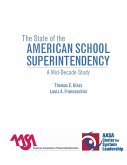Derrick D Jordan, Dionne V McLaughlin
Navigating the Superintendency
Lessons from the Field on Increasing Longevity and Success
Versandkostenfrei innerhalb Deutschlands
89,99 €
inkl. MwSt.
Versandkostenfrei*
Erscheint vorauss. 19. März 2026
Melden Sie sich
hier
hier
für den Produktalarm an, um über die Verfügbarkeit des Produkts informiert zu werden.

45 °P sammeln
Derrick D Jordan, Dionne V McLaughlin
Navigating the Superintendency
Lessons from the Field on Increasing Longevity and Success
- Gebundenes Buch
This book will leverage the extant literature and wisdom of 19 veteran, successful superintendents who have served for five or more consecutive years in a district wherein a majority of the schools under their direction are meeting or exceeding the state's expectations for student performance. The target audience would be novice (i.e., those with less than three years of experience) and veteran superintendents, especially those who are desiring more stability and seeking improved outcomes. Professors of educational leadership/superintendent preparation programs and aspiring (doctoral students…mehr
Andere Kunden interessierten sich auch für
![Accessing the Superintendency Accessing the Superintendency]() Marilyn TallericoAccessing the Superintendency32,99 €
Marilyn TallericoAccessing the Superintendency32,99 €![Decision Making in the Superintendency Decision Making in the Superintendency]() Randy HetheringtonDecision Making in the Superintendency28,99 €
Randy HetheringtonDecision Making in the Superintendency28,99 €![State of the American School Superintendency State of the American School Superintendency]() Thomas E. GlassState of the American School Superintendency82,99 €
Thomas E. GlassState of the American School Superintendency82,99 €![Voices of Women Aspiring to the Superintendency Voices of Women Aspiring to the Superintendency]() Margaret GroganVoices of Women Aspiring to the Superintendency93,99 €
Margaret GroganVoices of Women Aspiring to the Superintendency93,99 €![Voices of Women Aspiring to the Superintendency Voices of Women Aspiring to the Superintendency]() Margaret GroganVoices of Women Aspiring to the Superintendency34,99 €
Margaret GroganVoices of Women Aspiring to the Superintendency34,99 €![Accessing the Superintendency Accessing the Superintendency]() Marilyn TallericoAccessing the Superintendency67,99 €
Marilyn TallericoAccessing the Superintendency67,99 €![Moving into the Superintendency Moving into the Superintendency]() Thomas KerstenMoving into the Superintendency40,99 €
Thomas KerstenMoving into the Superintendency40,99 €-
-
-
This book will leverage the extant literature and wisdom of 19 veteran, successful superintendents who have served for five or more consecutive years in a district wherein a majority of the schools under their direction are meeting or exceeding the state's expectations for student performance. The target audience would be novice (i.e., those with less than three years of experience) and veteran superintendents, especially those who are desiring more stability and seeking improved outcomes. Professors of educational leadership/superintendent preparation programs and aspiring (doctoral students in particular) will also find the book to be of interest of them. Through structured interviews, the authors have identified lessons, skills, practices and dispositions that have led to successful outcomes, all of which could have a positive impact on the readers' longevity and overall efforts to support their students, staff, and communities in quality ways.
Produktdetails
- Produktdetails
- Verlag: Bloomsbury Academic
- Seitenzahl: 144
- Erscheinungstermin: 19. März 2026
- Englisch
- Abmessung: 229mm x 152mm x 25mm
- Gewicht: 454g
- ISBN-13: 9781475875287
- ISBN-10: 1475875282
- Artikelnr.: 75343917
- Herstellerkennzeichnung
- Libri GmbH
- Europaallee 1
- 36244 Bad Hersfeld
- gpsr@libri.de
- Verlag: Bloomsbury Academic
- Seitenzahl: 144
- Erscheinungstermin: 19. März 2026
- Englisch
- Abmessung: 229mm x 152mm x 25mm
- Gewicht: 454g
- ISBN-13: 9781475875287
- ISBN-10: 1475875282
- Artikelnr.: 75343917
- Herstellerkennzeichnung
- Libri GmbH
- Europaallee 1
- 36244 Bad Hersfeld
- gpsr@libri.de
Derrick D. Jordan & Dionne V. McLaughlin
Table of Contents
Chapter 1: Drinking from a Firehose
A. Thrust into the Driver's Seat: The New Kid on the Block
B. The Divided Board: A Potential Landmine
C. Understanding the District's Landscape
D. Evolution of the Superintendent's Role
E. A Seemingly Impossible Job: The Persistent Challenges
F. A Steep Learning Curve for New Superintendents
G. Leadership Tips for New Superintendents
H. Concluding Thoughts
I. Case Study #1: The Outsider
J. Case Study #2: The Rise and Fall of a Turnaround Superintendent
Chapter 2: It is a People Business. It Always Has Been and Always Will Be.
A. Put a Good Team Around You and Let Them Utilize Their Expertise
B. Considering Leadership Placement and the Responsibilities of Central
Office Staff
C. Get Good at Reading People and Knowing Who to Trust
D. Find a Mentor or Thought Partner. Don't Wait for One to Show Up.
E. Female Superintendent Perspectives on Mentoring
F. Small, Rural Districts: Starting Place for Several Latina
Superintendents in California and Texas
G. Woman Leader of Color Shares Lessons Learned from Mentor's Missteps
H. When Adults Behave Badly
I. Small Districts: Learning What People Value, And Being Relatable and
Approachable
J. Strong Family Relationships: A Key Ingredient
K. The Power of the Community to Save a Superintendency
L. Concluding Thoughts
Chapter 3: If You Don't Navigate Your School Board Successfully, They Won't
Let You Last
A. Clarify Roles and Orient New Board Members
B. Make Trust a Priority
C. Communicate, Communicate, Communicate
D. Get on the Same (or at Least a Similar) Accord
E. Get to Know Board Members
F. Where There is a Quorum, There Should Ye Be Also
G. Leverage the Board Chair
H. Do Not Under- or Overestimate Rouge Board Members
I. Know Who controls the Funding and Stay Connected
J. Concluding Thoughts
K. Case Study #3: Just Let me Do My Job!
L. Case Study #4: Leadership in Crisis: The Southwest Fletcher Consolidated
School Board
Chapter 4: Reversing the Course: Leading High Achieving Districts Where
Students of Color Are Successful
A. Examining (in a Trusting Environment) What Adults Can Do Differently
B. Diverse Public Schools Contrast Sharply with the Cultural Backgrounds of
Principals and Superintendents
C. Culturally Responsive School and District Leadership
D. Anything You Wouldn't Do for Your Own Children, You Shouldn't Do for
Children in Your District
E. Leading Instructional Dialogues
F. Investing In People (Not Programs) To Get Them to Do Better and
Celebrating Successes Like the 4th of July
G. Utilizing Strategies to Explicitly Address Inequities
H. How Does the Strategic Calculator Work?
I. Once Goals Are Set, How Do Schools Realize Them?
J. How Was the Strategic Calculator Developed?
K. Utilizing the Culturally Responsive Classroom Walkthrough Instrument
L. Data Analysis, Identifying Best Opportunities for Improvement,
Problem-Solving and Developing Focus Areas
M. High School Focus Groups: Instrumental in Identifying Strategies to
Improve Student Outcomes/Experiences
N. Concluding Thoughts
O. Case Study #5: Helping Principal Whitley Lead an Equitable,
High-Achieving School
Chapter 5: It Did Not Get This Bad Overnight.
A. The Pace of Change
B. The Knoster Model
C. Leading Changes in Academic Achievement
D. Visiting 40+ Classes a Year in a Small District and Charting School
Progress
E. Advanced Teacher Mentoring Positions
F. Supporting Innovative Principal Ideas and Eliminating Excuses
G. Changing Systems and Protocols
H. Politics, Policy and the Business Side of the Job
I. Hiring the Right Chief Finance Officer (CFO) and Admitting What You
Don't Know
J. Chief Financial Officer's Advice for Superintendents
K. Developing Budget Non-Negotiables and Averting Issues with District
Finances
L. What Superintendents Should Know about the Budget Before Accepting the
Job
M. Selecting and Supporting Principals
N. Developing District Systems for Improving Student Performance
O. Principals Whose Students Did Not Meet Growth Placed on Support Plans
P. Concluding Thoughts
Chapter 6: Making Better Decisions: How Superintendents Resolve Complex
Matters
A. Decisions to Eliminate Budget Deficits
B. How Long Does It Take to Eliminate a Budget Deficit
C. Inclement Weather Decisions: Snow, Hurricanes, and the Like
D. Permanently Closing Schools
E. Does This Help Our Kids? Is it Best for Our Schools?
F. Chief Finance Officer's Advice on Closing Schools
G. Leadership Decision-Making Approach: Like Playing 3-D Chess
H. Is it Legal, Moral, Ethical, Aligned with Policy?
I. How Core Values and Your "North Star" Guide Decision-Making
J. Board Member's Daughter-in-Law Applied Multiple Times for a District
Position
K. Employee Reductions-in-Force
L. Firing A Principal
M. Removing A Football Coach
N. Concluding Thoughts
O. Case Study #5: Involuntary Teacher Transfers
Chapter 7: You've Got to Keep the Job to Do the Job.
A. Tips for Landing and Keeping the Job: Advice a School Board Attorney
B. Negotiating Your Contract
C. Get Good at Specific Skills that Make You Indispensable
D. Leaving Every District Better Than I Found It Academically and
Financially
E. Charge to Institutions of Higher Education (IHEs): Better Preparation
for the Superintendency
F. Make Time to Power Down and Unplug
G. Concluding Thoughts
Chapter 1: Drinking from a Firehose
A. Thrust into the Driver's Seat: The New Kid on the Block
B. The Divided Board: A Potential Landmine
C. Understanding the District's Landscape
D. Evolution of the Superintendent's Role
E. A Seemingly Impossible Job: The Persistent Challenges
F. A Steep Learning Curve for New Superintendents
G. Leadership Tips for New Superintendents
H. Concluding Thoughts
I. Case Study #1: The Outsider
J. Case Study #2: The Rise and Fall of a Turnaround Superintendent
Chapter 2: It is a People Business. It Always Has Been and Always Will Be.
A. Put a Good Team Around You and Let Them Utilize Their Expertise
B. Considering Leadership Placement and the Responsibilities of Central
Office Staff
C. Get Good at Reading People and Knowing Who to Trust
D. Find a Mentor or Thought Partner. Don't Wait for One to Show Up.
E. Female Superintendent Perspectives on Mentoring
F. Small, Rural Districts: Starting Place for Several Latina
Superintendents in California and Texas
G. Woman Leader of Color Shares Lessons Learned from Mentor's Missteps
H. When Adults Behave Badly
I. Small Districts: Learning What People Value, And Being Relatable and
Approachable
J. Strong Family Relationships: A Key Ingredient
K. The Power of the Community to Save a Superintendency
L. Concluding Thoughts
Chapter 3: If You Don't Navigate Your School Board Successfully, They Won't
Let You Last
A. Clarify Roles and Orient New Board Members
B. Make Trust a Priority
C. Communicate, Communicate, Communicate
D. Get on the Same (or at Least a Similar) Accord
E. Get to Know Board Members
F. Where There is a Quorum, There Should Ye Be Also
G. Leverage the Board Chair
H. Do Not Under- or Overestimate Rouge Board Members
I. Know Who controls the Funding and Stay Connected
J. Concluding Thoughts
K. Case Study #3: Just Let me Do My Job!
L. Case Study #4: Leadership in Crisis: The Southwest Fletcher Consolidated
School Board
Chapter 4: Reversing the Course: Leading High Achieving Districts Where
Students of Color Are Successful
A. Examining (in a Trusting Environment) What Adults Can Do Differently
B. Diverse Public Schools Contrast Sharply with the Cultural Backgrounds of
Principals and Superintendents
C. Culturally Responsive School and District Leadership
D. Anything You Wouldn't Do for Your Own Children, You Shouldn't Do for
Children in Your District
E. Leading Instructional Dialogues
F. Investing In People (Not Programs) To Get Them to Do Better and
Celebrating Successes Like the 4th of July
G. Utilizing Strategies to Explicitly Address Inequities
H. How Does the Strategic Calculator Work?
I. Once Goals Are Set, How Do Schools Realize Them?
J. How Was the Strategic Calculator Developed?
K. Utilizing the Culturally Responsive Classroom Walkthrough Instrument
L. Data Analysis, Identifying Best Opportunities for Improvement,
Problem-Solving and Developing Focus Areas
M. High School Focus Groups: Instrumental in Identifying Strategies to
Improve Student Outcomes/Experiences
N. Concluding Thoughts
O. Case Study #5: Helping Principal Whitley Lead an Equitable,
High-Achieving School
Chapter 5: It Did Not Get This Bad Overnight.
A. The Pace of Change
B. The Knoster Model
C. Leading Changes in Academic Achievement
D. Visiting 40+ Classes a Year in a Small District and Charting School
Progress
E. Advanced Teacher Mentoring Positions
F. Supporting Innovative Principal Ideas and Eliminating Excuses
G. Changing Systems and Protocols
H. Politics, Policy and the Business Side of the Job
I. Hiring the Right Chief Finance Officer (CFO) and Admitting What You
Don't Know
J. Chief Financial Officer's Advice for Superintendents
K. Developing Budget Non-Negotiables and Averting Issues with District
Finances
L. What Superintendents Should Know about the Budget Before Accepting the
Job
M. Selecting and Supporting Principals
N. Developing District Systems for Improving Student Performance
O. Principals Whose Students Did Not Meet Growth Placed on Support Plans
P. Concluding Thoughts
Chapter 6: Making Better Decisions: How Superintendents Resolve Complex
Matters
A. Decisions to Eliminate Budget Deficits
B. How Long Does It Take to Eliminate a Budget Deficit
C. Inclement Weather Decisions: Snow, Hurricanes, and the Like
D. Permanently Closing Schools
E. Does This Help Our Kids? Is it Best for Our Schools?
F. Chief Finance Officer's Advice on Closing Schools
G. Leadership Decision-Making Approach: Like Playing 3-D Chess
H. Is it Legal, Moral, Ethical, Aligned with Policy?
I. How Core Values and Your "North Star" Guide Decision-Making
J. Board Member's Daughter-in-Law Applied Multiple Times for a District
Position
K. Employee Reductions-in-Force
L. Firing A Principal
M. Removing A Football Coach
N. Concluding Thoughts
O. Case Study #5: Involuntary Teacher Transfers
Chapter 7: You've Got to Keep the Job to Do the Job.
A. Tips for Landing and Keeping the Job: Advice a School Board Attorney
B. Negotiating Your Contract
C. Get Good at Specific Skills that Make You Indispensable
D. Leaving Every District Better Than I Found It Academically and
Financially
E. Charge to Institutions of Higher Education (IHEs): Better Preparation
for the Superintendency
F. Make Time to Power Down and Unplug
G. Concluding Thoughts
Table of Contents
Chapter 1: Drinking from a Firehose
A. Thrust into the Driver's Seat: The New Kid on the Block
B. The Divided Board: A Potential Landmine
C. Understanding the District's Landscape
D. Evolution of the Superintendent's Role
E. A Seemingly Impossible Job: The Persistent Challenges
F. A Steep Learning Curve for New Superintendents
G. Leadership Tips for New Superintendents
H. Concluding Thoughts
I. Case Study #1: The Outsider
J. Case Study #2: The Rise and Fall of a Turnaround Superintendent
Chapter 2: It is a People Business. It Always Has Been and Always Will Be.
A. Put a Good Team Around You and Let Them Utilize Their Expertise
B. Considering Leadership Placement and the Responsibilities of Central
Office Staff
C. Get Good at Reading People and Knowing Who to Trust
D. Find a Mentor or Thought Partner. Don't Wait for One to Show Up.
E. Female Superintendent Perspectives on Mentoring
F. Small, Rural Districts: Starting Place for Several Latina
Superintendents in California and Texas
G. Woman Leader of Color Shares Lessons Learned from Mentor's Missteps
H. When Adults Behave Badly
I. Small Districts: Learning What People Value, And Being Relatable and
Approachable
J. Strong Family Relationships: A Key Ingredient
K. The Power of the Community to Save a Superintendency
L. Concluding Thoughts
Chapter 3: If You Don't Navigate Your School Board Successfully, They Won't
Let You Last
A. Clarify Roles and Orient New Board Members
B. Make Trust a Priority
C. Communicate, Communicate, Communicate
D. Get on the Same (or at Least a Similar) Accord
E. Get to Know Board Members
F. Where There is a Quorum, There Should Ye Be Also
G. Leverage the Board Chair
H. Do Not Under- or Overestimate Rouge Board Members
I. Know Who controls the Funding and Stay Connected
J. Concluding Thoughts
K. Case Study #3: Just Let me Do My Job!
L. Case Study #4: Leadership in Crisis: The Southwest Fletcher Consolidated
School Board
Chapter 4: Reversing the Course: Leading High Achieving Districts Where
Students of Color Are Successful
A. Examining (in a Trusting Environment) What Adults Can Do Differently
B. Diverse Public Schools Contrast Sharply with the Cultural Backgrounds of
Principals and Superintendents
C. Culturally Responsive School and District Leadership
D. Anything You Wouldn't Do for Your Own Children, You Shouldn't Do for
Children in Your District
E. Leading Instructional Dialogues
F. Investing In People (Not Programs) To Get Them to Do Better and
Celebrating Successes Like the 4th of July
G. Utilizing Strategies to Explicitly Address Inequities
H. How Does the Strategic Calculator Work?
I. Once Goals Are Set, How Do Schools Realize Them?
J. How Was the Strategic Calculator Developed?
K. Utilizing the Culturally Responsive Classroom Walkthrough Instrument
L. Data Analysis, Identifying Best Opportunities for Improvement,
Problem-Solving and Developing Focus Areas
M. High School Focus Groups: Instrumental in Identifying Strategies to
Improve Student Outcomes/Experiences
N. Concluding Thoughts
O. Case Study #5: Helping Principal Whitley Lead an Equitable,
High-Achieving School
Chapter 5: It Did Not Get This Bad Overnight.
A. The Pace of Change
B. The Knoster Model
C. Leading Changes in Academic Achievement
D. Visiting 40+ Classes a Year in a Small District and Charting School
Progress
E. Advanced Teacher Mentoring Positions
F. Supporting Innovative Principal Ideas and Eliminating Excuses
G. Changing Systems and Protocols
H. Politics, Policy and the Business Side of the Job
I. Hiring the Right Chief Finance Officer (CFO) and Admitting What You
Don't Know
J. Chief Financial Officer's Advice for Superintendents
K. Developing Budget Non-Negotiables and Averting Issues with District
Finances
L. What Superintendents Should Know about the Budget Before Accepting the
Job
M. Selecting and Supporting Principals
N. Developing District Systems for Improving Student Performance
O. Principals Whose Students Did Not Meet Growth Placed on Support Plans
P. Concluding Thoughts
Chapter 6: Making Better Decisions: How Superintendents Resolve Complex
Matters
A. Decisions to Eliminate Budget Deficits
B. How Long Does It Take to Eliminate a Budget Deficit
C. Inclement Weather Decisions: Snow, Hurricanes, and the Like
D. Permanently Closing Schools
E. Does This Help Our Kids? Is it Best for Our Schools?
F. Chief Finance Officer's Advice on Closing Schools
G. Leadership Decision-Making Approach: Like Playing 3-D Chess
H. Is it Legal, Moral, Ethical, Aligned with Policy?
I. How Core Values and Your "North Star" Guide Decision-Making
J. Board Member's Daughter-in-Law Applied Multiple Times for a District
Position
K. Employee Reductions-in-Force
L. Firing A Principal
M. Removing A Football Coach
N. Concluding Thoughts
O. Case Study #5: Involuntary Teacher Transfers
Chapter 7: You've Got to Keep the Job to Do the Job.
A. Tips for Landing and Keeping the Job: Advice a School Board Attorney
B. Negotiating Your Contract
C. Get Good at Specific Skills that Make You Indispensable
D. Leaving Every District Better Than I Found It Academically and
Financially
E. Charge to Institutions of Higher Education (IHEs): Better Preparation
for the Superintendency
F. Make Time to Power Down and Unplug
G. Concluding Thoughts
Chapter 1: Drinking from a Firehose
A. Thrust into the Driver's Seat: The New Kid on the Block
B. The Divided Board: A Potential Landmine
C. Understanding the District's Landscape
D. Evolution of the Superintendent's Role
E. A Seemingly Impossible Job: The Persistent Challenges
F. A Steep Learning Curve for New Superintendents
G. Leadership Tips for New Superintendents
H. Concluding Thoughts
I. Case Study #1: The Outsider
J. Case Study #2: The Rise and Fall of a Turnaround Superintendent
Chapter 2: It is a People Business. It Always Has Been and Always Will Be.
A. Put a Good Team Around You and Let Them Utilize Their Expertise
B. Considering Leadership Placement and the Responsibilities of Central
Office Staff
C. Get Good at Reading People and Knowing Who to Trust
D. Find a Mentor or Thought Partner. Don't Wait for One to Show Up.
E. Female Superintendent Perspectives on Mentoring
F. Small, Rural Districts: Starting Place for Several Latina
Superintendents in California and Texas
G. Woman Leader of Color Shares Lessons Learned from Mentor's Missteps
H. When Adults Behave Badly
I. Small Districts: Learning What People Value, And Being Relatable and
Approachable
J. Strong Family Relationships: A Key Ingredient
K. The Power of the Community to Save a Superintendency
L. Concluding Thoughts
Chapter 3: If You Don't Navigate Your School Board Successfully, They Won't
Let You Last
A. Clarify Roles and Orient New Board Members
B. Make Trust a Priority
C. Communicate, Communicate, Communicate
D. Get on the Same (or at Least a Similar) Accord
E. Get to Know Board Members
F. Where There is a Quorum, There Should Ye Be Also
G. Leverage the Board Chair
H. Do Not Under- or Overestimate Rouge Board Members
I. Know Who controls the Funding and Stay Connected
J. Concluding Thoughts
K. Case Study #3: Just Let me Do My Job!
L. Case Study #4: Leadership in Crisis: The Southwest Fletcher Consolidated
School Board
Chapter 4: Reversing the Course: Leading High Achieving Districts Where
Students of Color Are Successful
A. Examining (in a Trusting Environment) What Adults Can Do Differently
B. Diverse Public Schools Contrast Sharply with the Cultural Backgrounds of
Principals and Superintendents
C. Culturally Responsive School and District Leadership
D. Anything You Wouldn't Do for Your Own Children, You Shouldn't Do for
Children in Your District
E. Leading Instructional Dialogues
F. Investing In People (Not Programs) To Get Them to Do Better and
Celebrating Successes Like the 4th of July
G. Utilizing Strategies to Explicitly Address Inequities
H. How Does the Strategic Calculator Work?
I. Once Goals Are Set, How Do Schools Realize Them?
J. How Was the Strategic Calculator Developed?
K. Utilizing the Culturally Responsive Classroom Walkthrough Instrument
L. Data Analysis, Identifying Best Opportunities for Improvement,
Problem-Solving and Developing Focus Areas
M. High School Focus Groups: Instrumental in Identifying Strategies to
Improve Student Outcomes/Experiences
N. Concluding Thoughts
O. Case Study #5: Helping Principal Whitley Lead an Equitable,
High-Achieving School
Chapter 5: It Did Not Get This Bad Overnight.
A. The Pace of Change
B. The Knoster Model
C. Leading Changes in Academic Achievement
D. Visiting 40+ Classes a Year in a Small District and Charting School
Progress
E. Advanced Teacher Mentoring Positions
F. Supporting Innovative Principal Ideas and Eliminating Excuses
G. Changing Systems and Protocols
H. Politics, Policy and the Business Side of the Job
I. Hiring the Right Chief Finance Officer (CFO) and Admitting What You
Don't Know
J. Chief Financial Officer's Advice for Superintendents
K. Developing Budget Non-Negotiables and Averting Issues with District
Finances
L. What Superintendents Should Know about the Budget Before Accepting the
Job
M. Selecting and Supporting Principals
N. Developing District Systems for Improving Student Performance
O. Principals Whose Students Did Not Meet Growth Placed on Support Plans
P. Concluding Thoughts
Chapter 6: Making Better Decisions: How Superintendents Resolve Complex
Matters
A. Decisions to Eliminate Budget Deficits
B. How Long Does It Take to Eliminate a Budget Deficit
C. Inclement Weather Decisions: Snow, Hurricanes, and the Like
D. Permanently Closing Schools
E. Does This Help Our Kids? Is it Best for Our Schools?
F. Chief Finance Officer's Advice on Closing Schools
G. Leadership Decision-Making Approach: Like Playing 3-D Chess
H. Is it Legal, Moral, Ethical, Aligned with Policy?
I. How Core Values and Your "North Star" Guide Decision-Making
J. Board Member's Daughter-in-Law Applied Multiple Times for a District
Position
K. Employee Reductions-in-Force
L. Firing A Principal
M. Removing A Football Coach
N. Concluding Thoughts
O. Case Study #5: Involuntary Teacher Transfers
Chapter 7: You've Got to Keep the Job to Do the Job.
A. Tips for Landing and Keeping the Job: Advice a School Board Attorney
B. Negotiating Your Contract
C. Get Good at Specific Skills that Make You Indispensable
D. Leaving Every District Better Than I Found It Academically and
Financially
E. Charge to Institutions of Higher Education (IHEs): Better Preparation
for the Superintendency
F. Make Time to Power Down and Unplug
G. Concluding Thoughts







